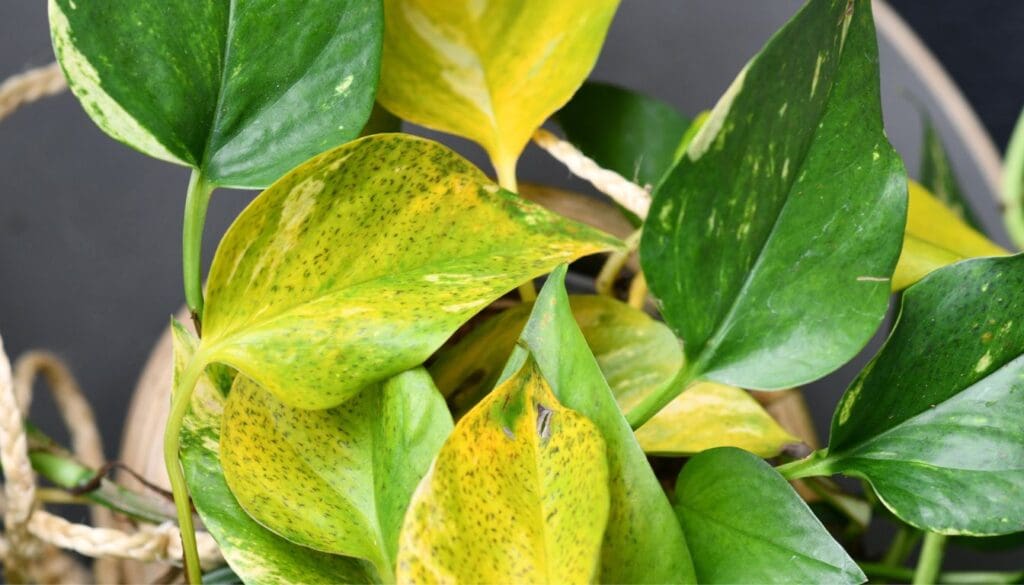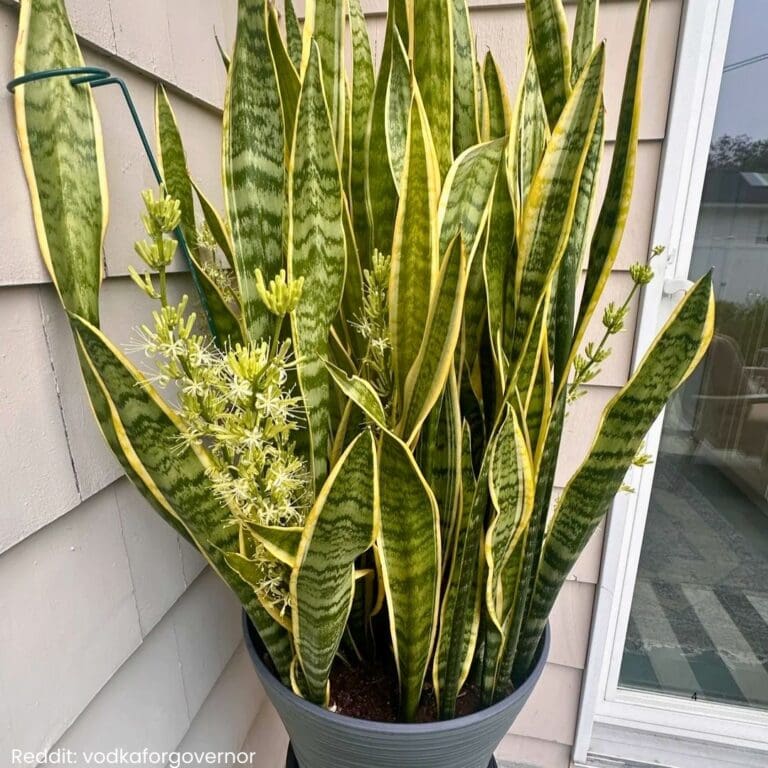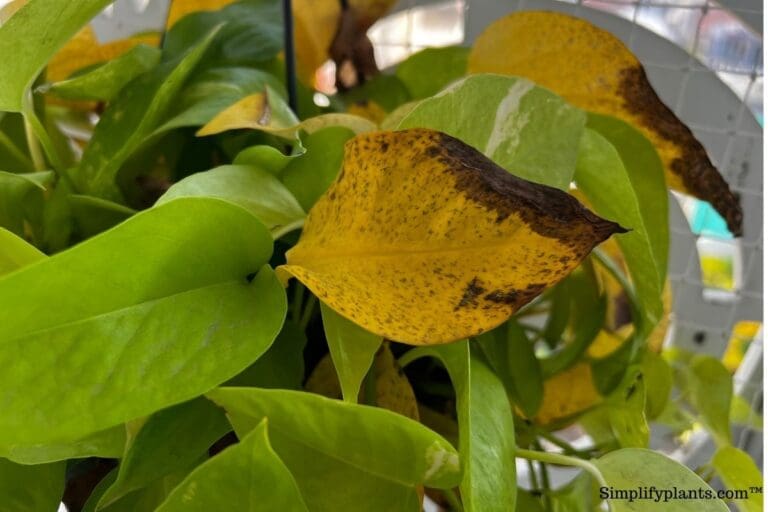The Best Soil Mix For Pothos? 9 DIY Soil Mix From My Experience!
Pothos are very resilient and low maintenance. But still, you would want to provide the best conditions for them to thrive. Picking the right soil mix is crucial for Pothos to grow well.
Pothos need well-drained, fertile soil with a pH of 6.1-6.8. The soil should also retain moisture and provide good aeration. A soil mix of 2 parts peat, 1 part perlite, and 1 part pine bark is best for Pothos as it will provide sound drainage and aeration to the plant.
Need guidance on Pothos soil mixes? During my 12 years of gardening, I have found 9 soil recipes that work for my Pothos. Read on to discover ideal soil types, signs of wrong soil, and DIY or store-bought options for your Pothos.

Please note: Simplify Plants is reader-supported. Some links in the post are affiliate links and I get a commission from purchases made through links in the post.
Ideal soil type for Pothos: Factors to consider
Soil is the home for Pothos and all plants, so you must choose it wisely.
The best soil for Pothos depends on factors such as drainage, retention, fertility, and pH level.
Let’s look at these aspects you need to consider before choosing a soil mix for your Pothos.
Pothos soil pH
Pothos thrive best in soil with a pH level of 6.1 to 6.8.
However, Pothos can tolerate a little outside this pH range. Anything with a pH of 5.8 or below will be highly acidic.
Highly acidic soil harms roots, stunts growth, and hinders plant energy.
Nutrient soil for Pothos
Pothos will get most of its nutrients from the soil.
Hence, using a nutrient-rich soil mix for these plants is crucial.
Pothos absorb most nutrients when actively growing.
Over time, the soil depletes.
But don’t worry. You can remedy that by using fertilizers.
But for the first few weeks after planting or repotting, when you don’t feed the Pothos.
They receive maximum nutrients from the soil.
Drainage and moisture in Pothos soil
Drainage is crucial when choosing an ideal potting mix for Pothos.
Pothos need to stay consistently moist, but they also need a dry spell before every watering session.
The water will remain stagnant with poorly drained soil and cause root rot.
Well-drained soil removes excess moisture while retaining the necessary amount.
The soil’s top few inches will dry 7-10 days after watering.
Retention qualities in Pothos soil
Along with drainage, Pothos soil must also have good retention qualities.
Poor retention quality makes the soil drain before Pothos can absorb needed moisture and nutrients.
It suffers from dehydration and nutrient deficiency.
The soil should be able to hold adequate moisture and nutrients.
Pothos like to dry out gradually before each watering.
Soil aeration for Pothos
Aeration is also essential for Pothos.
The soil should have enough air pockets for the roots to have enough oxygen and good air exchange.
It prevents root rot significantly.
I recommend well-aerated, chunky soil that contains enough air pockets.
Soil components and amendments to use in Pothos potting mix

There are various ingredients to use in an ideal soil mix.
But do you know what those ingredients are and how they help?
Understanding these ingredients and their benefits helps create an ideal Pothos blend.
Whether homemade or store-bought soil, ensure the soil has these ingredients. If not all, most of them must be present.
Now, let’s have a look at these ingredients:
- Pine bark fines are small mulch shavings. They help in improving soil acidity and moisture retention.
- Perlite is a broken volcanic rock that enhances retention, drainage, and aeration. Basically, it’s an all-rounder.
- Vermiculite is a lightweight soil amendment that improves moisture and nutrient retention.
- Sand helps in fast drainage.
- Pumice are lightweight volcanic rocks that improve drainage and aeration.
- Coco coir is a fibrous material made from coconut husk that helps enhance aeration.
- Compost or organic matter adds necessary nutrients to the soil.
- Sphagnum peat moss is a non-renewable resource gathered from wetlands and bogs. It improves soil acidity, moisture retention, and drainage.
- Soil activator is a commercial product. It contains humic acids that increase the composting process and nutrient levels in the soil.
Signs you are using the wrong potting soil for Pothos
It is common for a beginner to use the wrong potting soil for Pothos.
I have also been through this stage once when I began growing this beautiful vining tropical plant.
I learned this the hard way by making some of my precious Pothos suffer and losing two of them.
After several experiences, below are some common signs Pothos shows to tell you that your soil choice for Pothos is wrong:
Discolored leaves
Yellow or brown leaves could indicate excessive moisture or root rot in Pothos.
But if your watering is correct, the soil is the issue.
Either it drains water too fast or too slow, for which the plant cannot receive moisture and nutrients properly, triggering yellowing or browning.
Wilted or drooping Pothos leaves
Wilting or drooping is a common and initial sign of dehydration in Pothos.
The Pothos soil mix may not retain moisture properly.
Pothos soil remains wet for too long or dries very quickly
Yellowing or wilting in Pothos can also indicate other issues.
For confirmation, check the soil.
If the soil remains wet after 1 week of watering, it has poor drainage.
If the soil dries out faster, your soil doesn’t have good retention.
Soft plant tissue in Pothos
Excessive moisture leads to soft tissues in Pothos.
High moisture will turn the tissues of the Pothos leaves to dark brown with soft spots; check the soil moisture.
If you have been watering correctly, this is the result of poor drainage.
Stunted growth in Pothos
Stunted growth in Pothos can result from excessive moisture, bone-dry soil, or lack of nutrition.
If watering and nutrition are right, check if the soil type is the issue.
Poorly drained soil keeps the soil wet and causes root rot.
Poor retention qualities don’t allow the Pothos soil to hold moisture and nutrients for long.
Pothos soil with wrong pH levels can alter the soil’s nutrient levels and hinder nutrient absorption, leading to stunted growth.
What can you do if you use the wrong soil mix for Pothos?

One option is to replace the existing potting mix by repotting Pothos.
You may not need to do that if the soil has only one problem.
Suppose Pothos soil retains well but doesn’t have sound drainage or vice versa, or the soil does not have the correct pH or nutrient level.
In such cases, you can amend your soil with a few ingredients and make it perfect for Pothos without repotting or soil replacement.
Here are a few examples:
- Add perlite, vermiculite, or coarse sand to improve soil drainage.
- For good aeration, add pine bark fines or coco coir.
- If the soil has poor retention qualities, add vermiculite and sphagnum peat moss to improve the retention qualities.
- If the soil is infertile, add organic matter or compost to increase the soil’s nutritional value.
- You can use lime to increase the soil pH or sulfur to lower it.
DIY Soil Mix Recipes for Pothos
Making your own soil mixes for Pothos is fun and exciting.
You can decide the quantity of each amendment based on whether you want more drainage, retention, aeration, or nutrition.
Though the process can be messy, your Pothos can thrive in this potting mix recipe if you have used the correct ratio of each amendment.
I keep getting DMs where readers ask me to share homemade soil mix recipes.
As a beginner, I also made several mistakes while choosing suitable potting mixes.
I wanted to provide multiple options.
Hence, after reading several articles, watching videos, and conducting thorough research, I found 9 soil recipes ideal for Pothos.
Simply choose a recipe, gather ingredients, and mix in the right ratio.
Let’s have a look at them:
Recipe 1 for Pothos:
Recipe 2 for Pothos:
- 1 part compost
- 1 part coco peat
- 1 part cactus potting mix
Recipe 3 for Pothos:
Recipe 4 for Pothos:
- 1 part peat
- 1 part coarse sand
- 1 part shredded bark
- 1 part perlite
Recipe 5 for Pothos:
Recipe 6 for Pothos:
- 1 part forest humus
- 1 part peat moss
- 1 part perlite
Recipe 7 for Pothos:
- 2 parts potting mix, for example, Miracle-Gro indoor potting mix
- 1 part perlite
Recipe 8 for Pothos:
- 2 parts worm castings
- 2 parts activated charcoal
- 4 parts coco coir
- 5 parts orchid bark
- 5 parts perlite
Recipe 9 for Pothos:
- 10 parts coco coir
- 5 parts perlite
- 4 parts vermiculite or shredded bark
- 1 part compost
Commercial potting mix for Pothos

Don’t you have time or feel too lazy to make your own soil recipes?
Don’t worry.
I have also collected information about the commercial or store-bought soil mixes for Pothos.
Here are a few commercial soil mixes for Pothos:
1. FoxFarm Ocean Forest Potting Soil Mix Indoor Outdoor for Garden and Plants | Plant Fertilizer | 12 Quarts | The Hydroponic City Stake
The mix includes sphagnum moss, earthworm castings, bat guano, fish emulsion, crab meal, and other aged forest products.
The mix is well-drained, has good aeration, and is nutritious for Pothos.
2. Miracle-Gro Indoor Potting Mix 6 qt., Grows beautiful Houseplants
The potting soil has sphagnum peat, perlite, and coco coir with some fertilizer and a wetting agent.
While the NPK ratio (0.25-0.13-0.19) is a little unbalanced, it works well for Pothos due to soil amendments.
3. Jessi Mae – Air Cleaning Plant Soil – Acidic Organic pH Balanced Potting Soil – for Peace Lily, Snake Plant, Pothos, Parlor Palm, and Other Indoor Plants – Well-Draining Potting Soil – 4 Quarts
The potting soil is meant explicitly for Pothos as it is organic, chemical-free, and slightly acidic.
Its texture is fluffy and supports good aeration.
4. FoxFarm FX14054 Happy Frog Potting Soil, 12 Quart
The potting mix contains microbes that help in efficient root development.
Sphagnum peat moss, perlite, forest humus, and worm castings improve drainage, aeration, and retention.
It also has dolomite lime and oyster shells that keep the pH around 6.3-6.8.
5. Miracle-Gro Moisture Control Potting Mix – Soil for Indoor & Outdoor Containers, Added Fertilizer Feeds Up to 6 Months, 8 qt.
Ingredients used in this potting soil are perlite, peat moss, coco coir, and processed forest products that improve drainage and retention.
It also contains balanced houseplant fertilizer, for which you don’t have to feed Pothos for 3-6 months.
6. Mother Earth Coco + Perlite Mix, Growing Media for Indoor and Outdoor Container Gardening, 1.8 cu. Ft.
The main amendments, coco coir and perlite, enhance drainage, retention, and aeration.
The soil mix can reduce overwatering and root rot risks.
Final thoughts
Choosing the right soil blend for Pothos is essential for its growth and development.
Ensure that the soil mix you use is well-drained, holds enough moisture, has good aeration, contains nutrients, and has a pH range between 6.1 and 6.8. While Pothos can tolerate soil pH up to 5.8, lower than this will harm them.
Discolored leaves, wet or dry soil, stunted growth, wilting, and soft plant tissues indicate that Pothos is growing in the wrong soil type. To avoid stress in Pothos, use the right blend.
You can make your own potting mix by mixing different ingredients or buying store-bought soil. I have shared several options for both. You can choose any of them or ask the market staff to give you the best one.
Regardless, your Pothos mix should include perlite, vermiculite, pumice, sand, peat moss, coco coir, pine bark fines, soil activators, or organic matter.
These amendments ensure sound drainage, improve aeration and moisture retention, provide the right pH level, and add good nutritional value.
Can I use a cactus or succulent potting mix for Pothos?
Cactus and succulents need very little moisture. Cactus or succulent potting mix has poor moisture retention. It won’t work for Pothos because it requires some moisture in the soil. Mix cactus mix with peat moss or compost to improve retention.
Is loam soil ideal for Pothos?
Loam is a good choice as it can drain and retain moisture properly because it has a balanced mixture of sand, clay, and silt.
Reference: Pothos Wikipedia
Recommended Garden Supplies
| Product Image | Our Recommended Gardening Supplies | Check Offers! |
|---|---|---|
Top Top
Top
Top
Top
Top
Top
Top
Top | rePotme Houseplant and Tropical Classic Potting Soil Mix | Check Offer On Amazon |
 Top
Top
Top
Top
Top
Top
Top
Top | Espoma Organic Indoor Plant Food | Check Offer On Amazon |
 Top
Top
Top
Top
Top
Top
Top
Top | GooingTop LED Grow Light 6000K Full Spectrum Clip Plant Growing Lamp | Check Offer On Amazon |
 Top
Top
Top
Top
Top
Top
Top
Top | Soil Moisture Meter | Check Offer On Amazon |
 Top
Top
Top
Top
Top
Top
Top
Top | Govee Hygrometer Thermometer, Bluetooth Enabled! | Check Offer On Amazon |
 Top
Top | LEVOIT Humidifiers for Large Room(Best For Plants) | Check Offer On Amazon |
 Top
Top
Top
Top
Top
Top
Top
Top | Upgraded DIY Automatic Drip Irrigation Kit, 15 Potted Houseplants Support | Check Offer On Amazon |
 Top
Top
Top
Top
Top
Top
Top
Top | Stainless Steel Heavy Duty Gardening Tool Set | Check Offer On Amazon |
 Top
Top
Top
Top
Top
Top
Top
Top | Bonide Insecticidal Soap | Check Offer On Amazon |
 Top
Top
Top
Top
Top
Top
Top
Top | Bonide 32 oz Spray Neem Oil for Organic Gardening | Check Offer On Amazon |
 Top
Top
Top
Top
Top
Top
Top
Top | Garden Safe Fungicide | Check Offer On Amazon |






